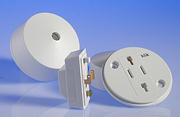Is there a general rule which states how many cores you can put into a single opening on a ceiling rose, the back of a plug socket, light switch or choc block?
I have seen various diagrams showing two and three cables going into a choc block on one side and only one coming out the other would this be ok or would it be classed as dangerous?
In a celling rose I have always had one core one opening can you put two cores into a single opening on a ceiling rose? or is it better to still have a single core going into the ceiling rose opening and then have two cores into a choc block?
I have seen wiring diagrams showing 3 cores into the back of a light switch where I presume they are looping is this perfectly fine or would this cause problems or anything dangerous?
I personally have only ever used a choc block for two cores maximum on a single side and celling roses and switches having a single core into each opening.
I am just curious as its what I have always done but I have seen diagrams showing different things... is it perfectly safe to have 3 or 4 cores going into a single side of a choc block or the back of a single gang switch?
What would people say the maximum is?
Thanks
James
I have seen various diagrams showing two and three cables going into a choc block on one side and only one coming out the other would this be ok or would it be classed as dangerous?
In a celling rose I have always had one core one opening can you put two cores into a single opening on a ceiling rose? or is it better to still have a single core going into the ceiling rose opening and then have two cores into a choc block?
I have seen wiring diagrams showing 3 cores into the back of a light switch where I presume they are looping is this perfectly fine or would this cause problems or anything dangerous?
I personally have only ever used a choc block for two cores maximum on a single side and celling roses and switches having a single core into each opening.
I am just curious as its what I have always done but I have seen diagrams showing different things... is it perfectly safe to have 3 or 4 cores going into a single side of a choc block or the back of a single gang switch?
What would people say the maximum is?
Thanks
James



